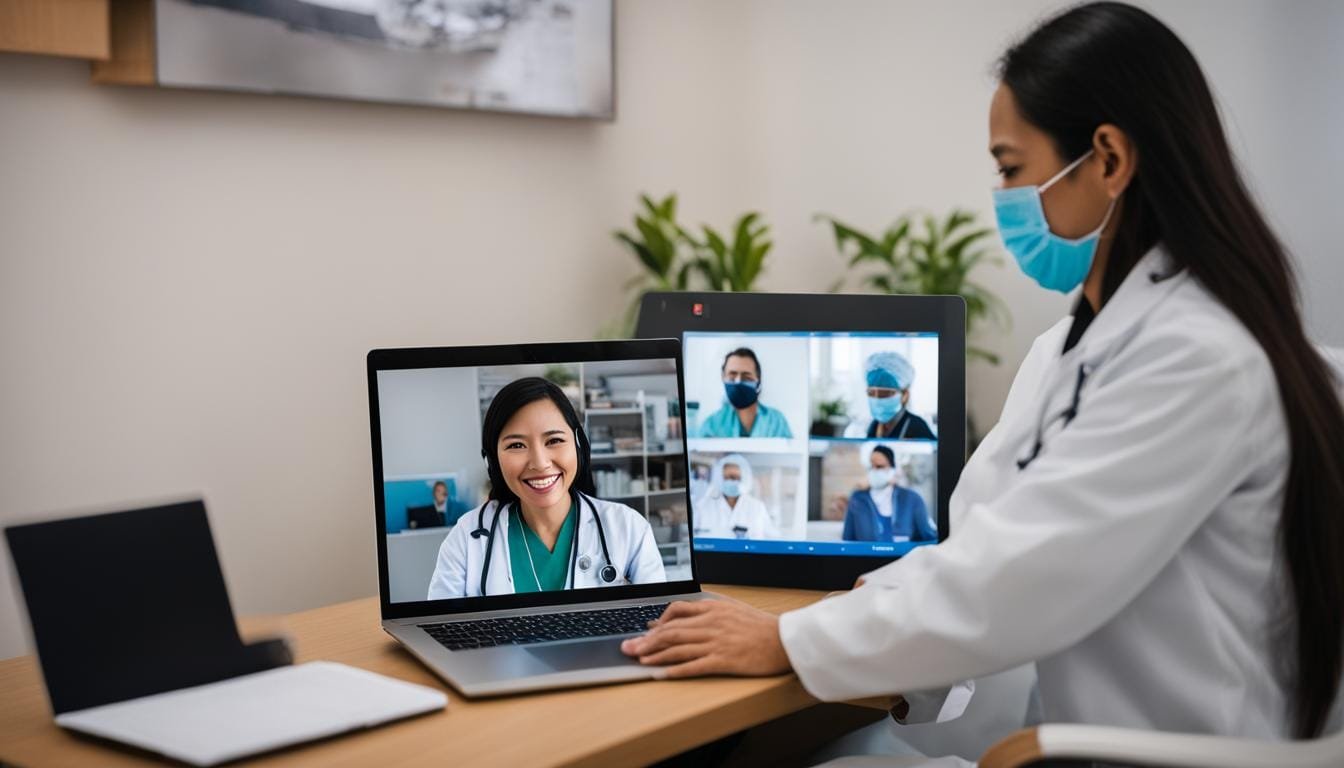Telehealth is revolutionizing healthcare delivery in Mexico, providing individuals with convenient and accessible online healthcare services. With virtual medical consultations and remote healthcare options, telehealth has transformed the way medical care is accessed and delivered.
Telemedicine in Mexico has been made possible through digital healthcare solutions, allowing patients to receive continuous, high-quality care without the need for in-person consultations. This has brought about improved healthcare outcomes and enhanced the patient experience.
Understanding the opportunities and challenges of telehealth is crucial for the future of healthcare in Mexico. Let’s explore the telehealth solutions, platforms, benefits, and technology that are shaping the landscape of digital healthcare in Mexico.
Key Takeaways:
- Telehealth in Mexico provides convenient and accessible online healthcare services.
- Virtual medical consultations and remote healthcare options have revolutionized healthcare delivery.
- Digital healthcare solutions have improved healthcare outcomes and patient experience.
- Understanding the opportunities and challenges of telehealth is crucial for the future of healthcare in Mexico.
- Telehealth solutions, platforms, benefits, and technology are shaping the landscape of digital healthcare in Mexico.
The Role of Telehealth in the COVID-19 Pandemic
The COVID-19 pandemic has had a profound impact on healthcare systems worldwide, including in Mexico. In the face of the crisis, telehealth has emerged as a crucial tool in ensuring continued access to healthcare services.
During these challenging times, telehealth has provided a safe and convenient option for non-emergency medical consultations. Virtual appointments have allowed patients to seek medical advice and treatment from the comfort of their homes, minimizing the risk of exposure to the virus while reducing the burden on healthcare facilities.
Telehealth platforms have played a vital role in enabling remote consultations. These platforms have facilitated virtual doctor-patient interactions, allowing individuals to receive timely medical advice, prescriptions, and follow-up care without the need for in-person visits. By leveraging telehealth technology, healthcare providers have been able to effectively manage patients’ health conditions and ensure continuity of care.
Additionally, telehealth has been instrumental in COVID-19 screening efforts. E-triage systems have been implemented to assess patients remotely and determine the urgency of their medical needs. This has helped healthcare professionals triage and prioritize cases, focusing resources on those requiring immediate attention.
Moreover, telehealth has enabled remote patient monitoring, allowing healthcare providers to track patients’ health conditions from a distance. Through the use of innovative digital tools, providers can monitor vital signs, medication adherence, and symptoms remotely. This not only improves patient outcomes but also reduces the need for frequent in-person visits, particularly for individuals with chronic conditions.
In times of crisis, telehealth has proven its value by providing safe, efficient, and accessible healthcare services. It has allowed patients to receive the care they need while minimizing the risk of exposure to infectious diseases. Telehealth platforms, e-triage systems, and remote patient monitoring have revolutionized the way healthcare is delivered and will continue to be vital even beyond the pandemic.
As the COVID-19 pandemic has accelerated the adoption of telehealth in Mexico and around the world, it has highlighted the importance and potential of virtual healthcare. The experience gained during this crisis will pave the way for further advancements in telehealth solutions, creating a more technology-driven and patient-centric healthcare system.
With telehealth platforms and services becoming increasingly sophisticated, it is expected that virtual care will remain an integral part of the healthcare landscape in Mexico. The convenience and accessibility offered by telehealth will continue to benefit patients, especially those in remote areas or with limited mobility. By leveraging telehealth solutions, Mexico can bridge the gap in healthcare access, improve patient outcomes, and enhance the overall quality of care.
The Benefits of Telehealth in the COVID-19 Pandemic
During the COVID-19 pandemic, telehealth has brought numerous benefits to both patients and healthcare providers:
- Safe and convenient access to healthcare services
- Reduced risk of exposure to infectious diseases
- Minimized burden on healthcare facilities
- Improved patient outcomes through remote monitoring
- Timely medical advice and treatment without in-person visits
These advantages have demonstrated the immense potential of telehealth, not only in times of crisis but also in the post-pandemic era. Embracing telehealth as a fundamental part of the healthcare system will contribute to the delivery of efficient, patient-centered care in Mexico.
| Benefits of Telehealth | Patients | Healthcare Providers |
|---|---|---|
| Improved healthcare access | ✔️ | ✔️ |
| Enhanced patient care and outcomes | ✔️ | ✔️ |
| Reduced healthcare costs | ✔️ | ✔️ |
| Convenience and flexibility | ✔️ | ✔️ |
Telehealth Services in Mexico: A Case Study
Telemed Mexico, a leading telehealth provider in Mexico, offers personalized telehealth services in popular tourist destinations such as Cancun and Playa del Carmen. This case study highlights the effectiveness of Telemed Mexico in providing convenient and accessible healthcare options for both residents and visitors.
Telemed Mexico specializes in personalized hotel consultations, bringing medical care directly to patients in the comfort of their accommodations. With the rise of telehealth, individuals can now receive high-quality medical care without the need for in-person consultations. This innovative approach allows patients to avoid unnecessary travel and wait times.
“Telemed Mexico provided me with exceptional telehealth services during my stay in Cancun. The convenience of receiving medical advice from the comfort of my hotel room was invaluable. The doctor was professional and thorough, addressing all of my concerns.”
In addition to hotel consultations, Telemed Mexico also offers COVID PCR testing services. This has become particularly important during the ongoing pandemic, as travelers require testing to comply with travel restrictions and health guidelines. Telemed Mexico ensures that individuals have access to reliable and efficient testing services, helping to ensure the safety and well-being of both residents and tourists.
Telemed Mexico’s telemedicine consultations start at $59 USD, making them an affordable option for individuals seeking medical advice or assistance. The combination of personalized hotel consultations and COVID PCR testing showcases the versatility and effectiveness of telehealth services in Mexico.
The Benefits of Telemed Mexico:
- Convenience and accessibility of personalized hotel consultations
- Reliable and efficient COVID PCR testing
- Affordable telemedicine consultations starting at $59 USD
- Enhanced patient experience with reduced travel and wait times
Telemed Mexico’s case study exemplifies how telehealth services are transforming the healthcare landscape in Mexico. By providing personalized medical care and convenient testing options, Telemed Mexico ensures that individuals can receive the healthcare services they need, whether they are residents or visitors in Cancun and Playa del Carmen.
The Benefits of Telehealth in Mexico
Telehealth has revolutionized healthcare access in Mexico, offering numerous benefits for patients, especially those with chronic conditions. Improved healthcare access is one of the key advantages of telehealth, as it enables individuals in rural and remote areas to receive medical care without the need for traveling long distances. This has been particularly beneficial for patients who previously faced challenges in accessing timely healthcare services.
Furthermore, telehealth allows for better management of chronic conditions through remote care and monitoring. Patients can now easily connect with healthcare professionals, receive regular check-ups, and have their conditions monitored from the comfort of their own homes. This not only improves the convenience for patients but also enhances their overall quality of life.
In addition, telehealth enhances patient care by reducing waiting times and enabling effective follow-up care. Patients no longer have to wait for hours in crowded waiting rooms, as telehealth offers the convenience of scheduled consultations from home. It also enables healthcare providers to proactively follow up with patients, ensuring that their treatment plans are monitored and adjusted as necessary.
Another significant benefit of telehealth is the cost savings it offers to both patients and healthcare providers. By eliminating transportation costs associated with traveling to and from medical facilities, telehealth reduces the financial burden on patients. Additionally, telehealth allows healthcare providers to operate more efficiently, providing care to a larger number of patients without the need for extensive physical infrastructure.
Overall, telehealth has transformed healthcare delivery in Mexico, bringing improved access, better management of chronic conditions, enhanced patient care, and cost savings. It is clear that telehealth is a valuable tool for modernizing the healthcare system and ensuring that high-quality care is accessible to all individuals, regardless of their geographic location.
| Benefit | Description |
|---|---|
| Improved healthcare access | Enables individuals in rural and remote areas to receive medical care without traveling long distances. |
| Better management of chronic conditions | Allows for remote care and monitoring, providing regular check-ups and condition management from home. |
| Enhanced patient care | Reduces waiting times, enables effective follow-up care, and provides timely medical advice and treatment. |
| Cost savings | Eliminates transportation costs for patients and increases healthcare provider efficiency. |
The Future of Telehealth in Mexico
The future of telehealth in Mexico is bright, driven by advancements in technology and the changing landscape of healthcare in the post-pandemic era. Telehealth is set to become an integral part of the healthcare system, bridging the gap in access to medical services for underserved populations and those in remote areas.
One of the key developments in the future of telehealth is the adoption of a hybrid model of care that combines both in-person and virtual consultations. This approach offers flexibility and convenience to patients while ensuring the highest quality of care. With the hybrid model, patients can choose whether to visit a healthcare facility or consult with a healthcare provider remotely, depending on their individual needs and preferences.
This shift towards a hybrid model of care is driven by the realization that telehealth solutions have the potential to reshape the healthcare landscape in Mexico. By leveraging technology-driven healthcare, telehealth enables accessible, patient-centered, and efficient medical services. Patients can benefit from virtual consultations, remote monitoring, and access to specialized care that may not be readily available in their local areas.
In terms of telehealth advancements, the future holds great promise. As technology continues to evolve, telehealth solutions will become more sophisticated, allowing for enhanced diagnosis, treatment, and patient monitoring. Wearable devices, artificial intelligence, and data analytics will play a significant role in improving healthcare outcomes and personalizing patient care.
To illustrate the potential of telehealth in Mexico, let’s explore a case study:
Case Study: Telemed Mexico
Telemed Mexico is a leading telehealth provider in the country, offering personalized telehealth services in popular tourist destinations such as Cancun and Playa del Carmen. Their services include hotel consultations and COVID PCR testing.
With telemedicine consultations starting at $59 USD, Telemed Mexico provides accessible healthcare options for both residents and visitors. Their services cater to the unique needs of individuals in remote areas or those seeking medical care while traveling.
By combining technology and medical expertise, Telemed Mexico demonstrates how telehealth can effectively triage patients, provide timely medical advice, and improve healthcare outcomes, particularly in industries where remote medical support is essential.
As telehealth continues to advance and become more widely adopted, it is important to address challenges such as regulatory frameworks and data privacy to ensure patient safety and quality care standards. The future of telehealth in Mexico depends on fostering collaboration between healthcare providers, policymakers, and technology developers to establish a sustainable and patient-centric telehealth ecosystem.
To summarize, the future of telehealth in Mexico holds great potential to revolutionize healthcare delivery. With telehealth advancements, the adoption of a hybrid model of care, and technology-driven healthcare solutions, the Mexican healthcare system is poised to provide accessible, efficient, and patient-centered medical services for all.
Conclusion
Telehealth in Mexico offers a multitude of benefits that enhance healthcare accessibility, improve chronic condition management, and elevate patient care. However, the implementation of telehealth faces its fair share of challenges, ranging from legal frameworks and data protection to interoperability and healthcare regulations. Despite these obstacles, the future of telehealth in Mexico looks promising, presenting opportunities for continuous advancements and integration into the healthcare system.
To ensure the sustainable growth of telehealth programs, it is crucial to establish regulatory frameworks that prioritize patient safety, privacy rights, and uncompromising quality care standards. These regulations will play a vital role in shaping the future of telehealth in Mexico, enabling it to become an integral part of the modernized healthcare system.
Telehealth’s potential to revolutionize healthcare accessibility and delivery cannot be overstated. By bridging the gap in healthcare access for underserved populations and individuals in remote areas, it has the power to transform lives and communities. As technology advances, telehealth will continue to evolve, offering a hybrid model of care that combines virtual consultations with in-person visits. This model will provide flexibility and convenience while maintaining the highest quality of care.
In summary, telehealth is set to reshape the healthcare landscape in Mexico, facilitating accessible, patient-centered, and efficient medical services. By leveraging the opportunities and addressing the challenges, Mexico’s healthcare system can embrace telehealth’s full potential, ensuring that every individual can access the care they need, when they need it.
FAQ
What is telehealth?
Telehealth refers to the use of digital technology to provide healthcare services remotely. It includes virtual medical consultations, remote monitoring, and other online healthcare services.
How has telehealth revolutionized healthcare delivery in Mexico?
Telehealth has made medical care more accessible and convenient in Mexico. It has improved healthcare access, especially in rural and remote areas, and enables continuous, high-quality care without the need for in-person consultations.
How has telehealth been used during the COVID-19 pandemic in Mexico?
Telehealth has played a crucial role during the pandemic in Mexico. It has provided a safe and convenient option for non-emergency medical consultations, allowed for COVID-19 screening and e-triage, and enabled remote patient monitoring without physical contact.
Can I receive telehealth services in popular tourist destinations in Mexico?
Yes, Telemed Mexico offers personalized telehealth services, including hotel consultations and COVID PCR testing, in popular tourist destinations such as Cancun and Playa del Carmen.
What are the benefits of telehealth in Mexico?
Telehealth offers improved access to medical care, better management of chronic conditions through remote care and monitoring, enhanced patient care by reducing waiting times and providing timely medical advice, and cost savings opportunities by eliminating transportation costs.
What does the future hold for telehealth in Mexico?
Telehealth will become an integral part of the healthcare system in Mexico. It will bridge the gap in healthcare access, offer a hybrid model of care combining in-person and virtual consultations, and reshape the healthcare landscape to provide accessible, patient-centered, and efficient medical services.
What are the challenges and opportunities for telehealth in Mexico?
Telehealth faces challenges in terms of legal frameworks, data protection, data interoperability, and healthcare regulations. However, there are opportunities for continued advancements and integration into the healthcare system in Mexico, with the need for regulatory frameworks that prioritize patient safety, privacy rights, and quality care standards.



